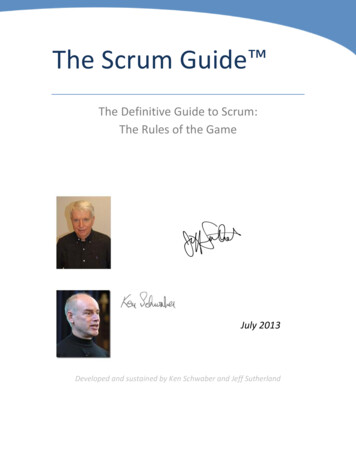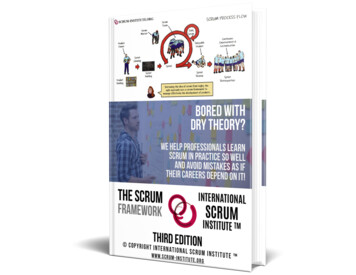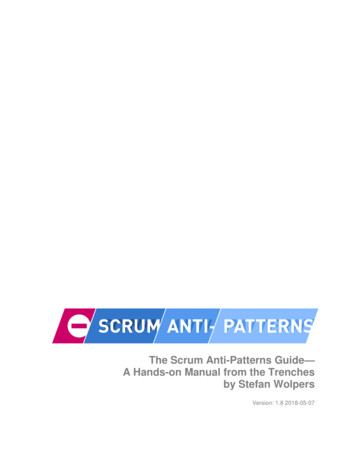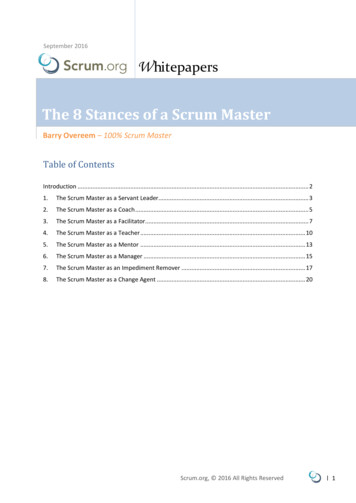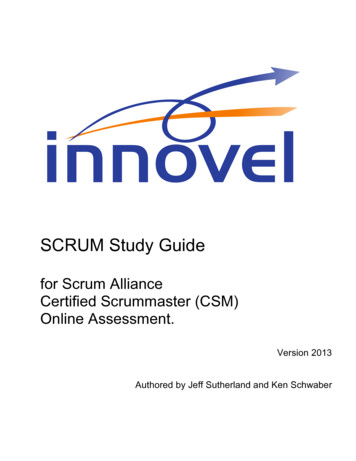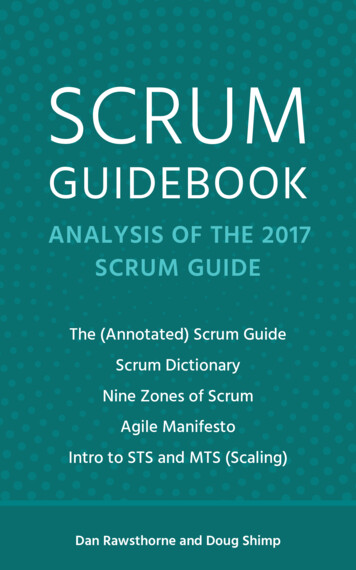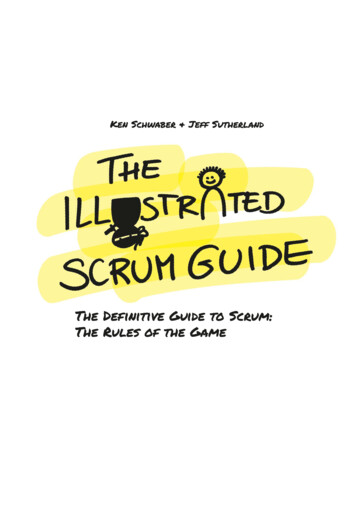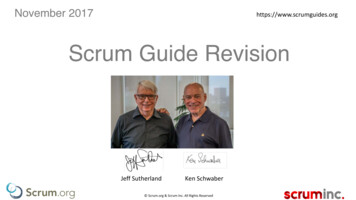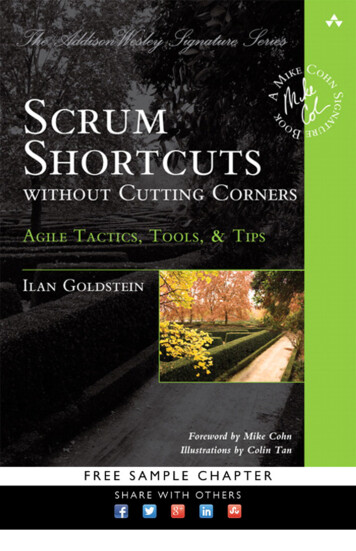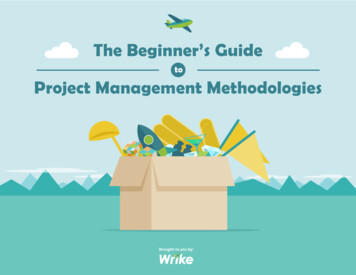
Transcription
The Beginner’s GuidetoProject Management MethodologiesBrought to you by:
Contents2CONTENTSWhy Should I ReadAbout Project Management Methodologies?Part 1: 16 Common MethodologiesAdaptive Project Framework (APF)AgileBenefits RealizationCritical Chain Project Management (CCPM)Critical Path Method (CPM)Event Chain Methodology (ECM)LeanPRINCE2PRiSMProcess-Based Project ManagementScrumSix SigmaLean Six SigmaWaterfallAppendix: Additional ResourcesExtreme Programming (XP)KanbanLearn more at wrike.comDo you like this book?Share it!
Why Should I Read About Project Management Methodologies?3Why Should I ReadAbout Project Management Methodologies?If you’ve been hanging around project management circles,you’ve probably heard heated debates arguing Agile vs.Waterfall, Scrum vs. Kanban, or the merits of PRINCE2.But what are project management methodologies exactly,and how do they help project teams work better? And whatmakes one methodology better than another?In this ebook, you’ll get: Bite-sized explanations of each methodology. The pros and cons of each approach to help you weighyour options. The details you need to choose the right frameworkThe truth is there is no one-size-fits-all approach. And ifthere were, it definitely wouldn’t be, “Let’s wing it!” Projectmanagement methodologies are all about finding the bestway to plan and execute a certain project.to organize and manage your tasks. A deeper confidence and understanding of the projectmanagement field.Even if you’re not a certified project manager, you maybe expected to perform — and deliver — like one. Thisebook will give you the essentials of 16 common PMmethodologies so you can choose the winning approach(and wow your boss) every time.Learn more at wrike.comDo you like this book?Share it!
16 Common Project ManagementMethodologies
Part 1: 16 Common Project Management Methodologies5How Should I Choosea Methodology?Picking a methodology is like deciding which recipeto follow when baking chocolate chip cookies. One recipemight use room-temperature butter while anotherrecommends melted margarine, or call for dark chocolateinstead of semi-sweet chips. Each recipe gives you deliciouscookies, but the steps, ingredients and techniques are alla little different to suit your tastebuds. You should picka methodology based on your available ingredients: projectconstraints, timeline, tools, and people.With that in mind, here are the 16 methodologies!Learn more at wrike.comDo you like this book?Share it!
Part 1: 16 Common Project Management Methodologies6Adaptive Project Framework(APF)The APF method strives to learn from experience. These projects begin witha Requirements Breakdown Structure to define strategic project goals basedon product requirements, functions, sub-functions, and features. As theyproceed, teams continually evaluate previous results to improve policiesand practices at each stage of the project lifecycle. Clients/stakeholders canchange project scope at the start of each stage so the team can create the mostbusiness value.PRO:This is a good approach for when you know what your goal is and aren’t sureof the best way to get there.CON:Due to its flexibility, APF may lead to project delays or increased budgets.Learn more at wrike.comDo you like this book?Share it!
Part 1: 16 Common Project Management Methodologies7AgileGreat chefs taste their food as they cook so they can add new ingredientsand create the best dish. Agile is like tasting our project as we go and adjustingit accordingly. Planning begins with clients describing how the end product willbe used, its benefits, and so on, so the team gets a good understandingof expectations. Once the project begins, teams cycle through a processof planning, executing, and evaluating — which might change the finaldeliverable. Continuous collaboration is key, both among team membersand with project stakeholders, to make fully-informed decisions.PRO:This approach is beneficial for creative projects with goalsthat are flexible and can be modified midway.CON:Timelines and budgets are difficult to define, and stakeholders must havethe time and desire to be actively involved in the day-to-day work.Learn more at wrike.comDo you like this book?Share it!
Part 1: 16 Common Project Management Methodologies8What’s the DifferenceBetween APF and Agile?Confused between the two? With APF, your end goal is clear, but your methodfor achieving that goal will change based on your experience at each stageof the project. With Agile, your end goals are less defined. Each stage bringsfeedback from stakeholders to help guide your decisions and improveor alter the final product.Learn more at wrike.comDo you like this book?Share it!
Part 1: 16 Common Project Management Methodologies9Benefits RealizationIt redefines success as not just delivering the package on time and with moneyto spare, but achieving a desired benefit. Here’s an example: say your clients wantto increase their sales conversion rate by 15%. They hire you to managethe development of a new CRM software that will help the sales team personalizetheir communications, track sales data, and determine ideal communicationtimelines. You deliver a CRM with those features on time and within budget.Success, right? What if your client’s sales conversion rates only increase by 5%?With benefits realization, your project isn’t successfully completed until the client’sdesired benefits are achieved — in this case, until the sales conversion rate is up 15%.PRO:This approach ensures that your projects contribute real valueto the business and deliver the end results your stakeholders care about.CON:Benefits aren’t always exact, measurable, or scientific, so it can be difficultto know if they’ve been achieved — or if your project actually contributed to thatsuccess. You’ll need to put careful thought into developing effective metricsto measure the outcomes of your project, such as ROI, process capability, fasterdelivery times, or higher customer satisfaction.Learn more at wrike.comDo you like this book?Share it!
Part 1: 16 Common Project Management Methodologies10Critical Chain ProjectManagement (CCPM)Project delays are usually caused by resources that aren’t available whenyou need them. CCPM avoids that by building a project schedule that firstidentifies a “critical chain” of tasks and then reserves resources for those tasks.Your project timeline may be longer, but you’ve got a higher probabilityof predicting realistic deadlines.PRO:Tasks can be collaborated on because you know that all key players willbe available when you need them.CON:This approach may not be effective for projects with short deadlines, since CCPMplans build in extra time buffers along the critical chain.Learn more at wrike.comDo you like this book?Share it!
Part 1: 16 Common Project Management Methodologies11Critical Path Method (CPM)Determine your project’s shortest timeline and adjust to shifting deadlines usingCPM. You’ll start by looking at all the tasks absolutely necessary to completeyour project, and then estimating completion times for each step, including taskdependencies, milestones, and final deliverables.PRO:Specific dates can be assigned to each task, so managers can compare whatshould be happening with what is happening on a daily basis. It’s optimal forprojects with short deadlines.CON:Critics say a major drawback is that CPM doesn’t consider resource availabilityin planning, so you may be left with an overly optimistic plan.Learn more at wrike.comDo you like this book?Share it!
Part 1: 16 Common Project Management Methodologies12Event Chain Methodology(ECM)Most projects don’t go exactly according to plan. Risks are difficult to identifyand analyze, and project managers may be under pressure by stakeholdersto create optimistic timelines, budgets, or deliverables. Event chain methodologyhelps recognize and plan for potential risks that may lie outside the projectscope. By using techniques like Monte Carlo Analysis and Event Chain Diagrams,project managers can see how external events affect project tasksand determine the probability of certain risks occurring.PRO:By visualizing the relationship between external events and tasks, managers cancreate more realistic project plans.CON:It’s easy to forget that external events aren’t just threats to your project — theycan also present opportunities. Don’t automatically squash all potential risks andfail to capitalize on fortunate circumstances.Learn more at wrike.comDo you like this book?Share it!
Part 1: 16 Common Project Management Methodologies13ExtremeProgramming (XP)Extreme Programming for software development features short developmentcycles, frequent releases, and constant client collaboration. Productivity is high,and the approach is well-suited to complex or undefined projects. Teams allowfor change within their sprints; if work hasn’t started on a particular feature,a similar task can be swapped out to replace it. Teams avoid overworkingthemselves through effective collaboration and by writing the simplest possiblecode to produce the desired feature.PRO:XP is efficient, with a focus on simplicity. Teams work at a sustainable pace,meaning no 80-hour work weeks leading to burnout and low-quality output.CON:Critics warn that XP’s strength lies too much in the ingenuity and abilitiesof unique team members rather than with the process itself.Learn more at wrike.comDo you like this book?Share it!
Part 1: 16 Common Project Management Methodologies14KanbanIf a continuous workflow and outputting a slow and steady streamof deliverables are your main priorities, Kanban is a good fit. Managers createvisual representations of the team’s workflow (often using a whiteboard or stickynotes) to uncover process problems and prevent tasks from stalling as unending“works in progress.” The sticky notes move across the board to tangiblyrepresent project progress.PRO:Kanban helps teams understand where their time is really being spent so youcan improve efficiency.CON:Variations in customer demand — like the start of the holiday season, or a dropoff due to a product recall — can make Kanban inefficient, since it’s designedto produce a small but steady output.Learn more at wrike.comDo you like this book?Share it!
Part 1: 16 Common Project Management Methodologies15Lean“Waste not, want not!” Lean is all about finding the path of least resistanceto get the results you want. Start by creating a full work-process breakdownto find and eliminate bottlenecks, delays, or other waste (called mura). Teamsfocus on the project’s true customer value, and on continuous processimprovement. The goal is to do more with less: deliver high-value, high-qualitywork with less manpower, less money, and less time.PRO:This approach is especially helpful if you need to cut your budget, meet quickdeadlines, or get big results with a small team.CON:Since the ultimate goal is to get things done faster and cheaper, stakeholdersneed to make prompt decisions and be prepared to stick to those decisions —weighing options for weeks interrupts the Lean process.Learn more at wrike.comDo you like this book?Share it!
Part 1: 16 Common Project Management Methodologies16PRINCE2Not to be confused with the Prince that sang “When Doves Cry,” thismethodology is also known as “PRojects IN Controlled Environments.”The project must have a business justification, so the first step is identifyinga clear need, a target customer, realistic benefits, and a thorough costassessment. A project board owns the project and is responsible for its success,while a project manager oversees day-to-day activities.PRO:The extensive documentation involved in PRINCE2 projects can be very helpfulwith corporate planning and performance tracking.CON:It can be difficult to adapt to project changes, since a lot of effort goesinto creating and maintaining those documents and logs at each stageof the process.Learn more at wrike.comDo you like this book?Share it!
Part 1: 16 Common Project Management Methodologies17PRiSMWant to go green? PRiSM (PRojects integrating Sustainable Methods) blendsproject planning with environmental sustainability measures. The aimis to complete projects efficiently, all while reducing a company’s negativeenvironmental footprint.PRO:Aligning corporate strategy with social responsibility and sustainability goals canbolster a company’s reputation, plus you could benefit from reduced energy,waste management, and distribution costs.CON:Environmental responsibility must be a priority at every level of the company —from executives to managers — for it to be truly successful.Learn more at wrike.comDo you like this book?Share it!
Part 1: 16 Common Project Management Methodologies18Process-BasedProject ManagementIt’s all about “mission accomplished.” Every project is defined by your companymission or vision statement, whether that be “Feed the Homeless” or “ImproveGlobal Collaboration.” Before project kick-off, the plan is analyzed to seeif it lives up to your mission statement; if it doesn’t, then all strategies and goalsare adjusted in order to meet that objective.PRO:This approach helps ensure that every project aligns with, and adds valueto, the organization’s strategic vision.CON:Adjusting every team’s projects and processes to fit the mission canbe very time-consuming. And it doesn’t allow for side projects, so if yourcompany wants to take on tasks unrelated to your values you’ll have to revisityour company mission statement first.Learn more at wrike.comDo you like this book?Share it!
Part 1: 16 Common Project Management Methodologies19Scrum“Productivity” is the name of the game. Small teams are facilitated by a scrummaster, whose job is to remove any barriers to team progress. Work is typicallydone in a series of two-week sprints, and team members are in constantcommunication through daily scrum meetings. Within the team, members areassigned roles as either pigs or chickens. A pig is responsible for the completionof a specific task. (They’re the ones “risking their bacon.”) Chickens may beinvolved in the task, but are not ultimately responsible.PRO:New developments can be tested quickly and mistakes are fixed right away.CON:Scrum projects are prone to scope creep. And because the team is a close unit,one member leaving can disrupt the whole project.Learn more at wrike.comDo you like this book?Share it!
Part 1: 16 Common Project Management Methodologies20What’s the Difference BetweenScrum and Extreme Programming?XP teams tackle tasks in a strict customer-determined order, whereas Scrumteams can determine their own timeline. Additionally, XP allows similar tasksto be swapped within a sprint, but Scrum tasks are meant to be set in stone untilthe end of the sprint.Learn more at wrike.comDo you like this book?Share it!
Part 1: 16 Common Project Management Methodologies21Six SigmaWhat’s your sigma rating? Six Sigma is a statistics-based quality improvementprocess aimed at reducing the number of defects (in manufacturingand industrial sectors), or bugs (in software development). A rating of “six sigma”indicates that 99.99966% of what is produced is defect-free.PRO:Six Sigma is a very proactive methodology, and it examines the entire productionprocess to identify improvements even before defects appear.CON:This holistic approach may also lead to less flexibility after the planning process,which could limit your team’s creativity and innovation.Learn more at wrike.comDo you like this book?Share it!
Part 1: 16 Common Project Management Methodologies22Lean Six SigmaIt combines Lean’s efficiency with Six Sigma’s statistics-based processimprovement. It corrects workflow problems and eliminates waste by helpingyou understand how work gets done and identify which aspects of your projectare most valuable to the client or customer.PRO:In addition to making your projects more efficient and cost effective,Lean Six Sigma keeps employees actively engaged in process improvement,leading to a sense of ownership and accountability.CON:Lean Six Sigma usually involves major change to the way work gets done,so make sure you — and company execs, stakeholders, and other managers —are prepared for the amount of time, effort, and resources needed to besuccessful with this method.Learn more at wrike.comDo you like this book?Share it!
Part 1: 16 Common Project Management Methodologies23WaterfallImagine the path of a waterfall: The river runs from the top and flows downto the bottom without steering away from the main course. It’s the samein project management. With clearly defined goals and a set timeline,teams work through tasks in sequence, completing one task before movingon to the next in line.PRO:Extensive planning goes into this approach, and this thoroughness often resultsin more accurate timelines and budgets.CON:It’s difficult to adapt to any project changes — or modify and correct previoussteps (water can’t run backwards!) — so you’ll need to be proactivein anticipating problems before they can affect your flow.Learn more at wrike.comDo you like this book?Share it!
Part 1: 16 Common Project Management Methodologies24Congrats!Now you have the knowledge you need to confidently lead your team to success.Decide which methodology is best suited for your projects, check out the Appendixto expand your knowledge with a little extra research, and go get things done!Learn more at wrike.comDo you like this book?Share it!
This ebook is brought to you by Wrike.Every project manager needs a powerful collaboration and managementtool to coordinate team efforts, adjust to changing priorities,and keep every project organized.With Wrike, your team can: manage multiple projects in one workspace collaborate in real-time and boost productivity through improved communications track project progress with visual analytics, including an interactive Gantt chartStart a free trial ›
Additional Resources
Appendix: Additional Resources27Have a few of these methodologies piqued your interest?If you think you’ve found the perfect choice for your next project, expand yourknowledge with some in-depth research and articles on each approach. Perusethe resources on this list and you’ll be a project management expert in no time.Learn more at wrike.comAdaptive Project Framework (APF)LeanAgilePRINCE2Benefits RealizationPRiSMCritical Chain Project Management (CCPM)Process-Based Project ManagementCritical Path Method (CPM)ScrumEvent Chain Methodology (ECM)Six SigmaExtreme Programming (XP)Lean Six SigmaKanbanWaterfallDo you like this book?Share it!
Appendix: Additional Resources28Project Management EssentialsProject Management TipsProject Management Basics: A Quickstart Glossary for Newbies5 Project Management Lessons to Learn from Superheroes(Part 1)Project Management Basics: A Quickstart Glossary for Newbies(Part 2)Project Management Basics: A Beginner’s Guide to Gantt ChartsWhat is a Gantt Chart? (Infographic)Fundamentals of the Scrum Methodology8 Attitudes Guaranteed to Sink Your Agile ProjectsStartups Should Lean on Lean Project ManagementUltimate Guide to Project Risk:Risk Assessment (Part 1) and Risk Management (Part 2)20 #Project Management Gurus to Follow on Twitter5 Project Management Groups to Join on LinkedIn12 Useful Project Management Boards on Pinterest15 Project Management Quotes to Live By [Infographic]5 Project Management Ideas that Should be ExtinctHow Neuroscience Can Make You a Better Project Manager4 Lessons Hockey Has Taught Me About Project Management10 Phrases That Can Ruin Your Project Kickoff Meeting15 Books Every Manager Should Read20 Online Training Resources for Project ManagersDon't forget to subscribeto the Wrike blog for moreproject management resources!Teamwork Across Borders: Secrets of Remote Collaboration[Recorded Webinar]5 Strategies for Forming Team Productivity Habits[Recorded Webinar]Sources: www.intaver.com, www.my-project-management-expert.com, www.wikipedia.org, www.brighthubpm.com, www.about.com, www.projectmanagement.com, www.projectsmart.co.uk, www.tutorialspoint.com, www.sixsigmaonline.org, www.pmkb.com.
Scrum Six Sigma Lean Six Sigma Waterfall Appendix: Additional Resources. Wh houl ea bout roject anagement ethoologies 3 Do ou like this book hare it! earn more at rikecom If you’ve been hanging around project management circle
